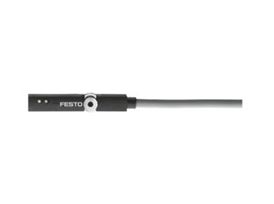Introduction to FESTO (Festo) Adjustable Pressure Switch PEV - 1/4 - B
FESTO (Festo), as a renowned company in the field of automation technology, has launched the adjustable pressure switch PEV - 1/4 - B, which is of significant importance in industrial production. This pressure switch features a compact design that can adapt to a variety of different installation environments. Its 1/4-inch interface size is a common specification in industry, facilitating connection with various pipes and equipment.
The main function of PEV - 1/4 - B is to precisely monitor and control pressure. It can adjust the pressure set value according to actual needs. When the system pressure reaches the set upper or lower limit, the pressure switch will respond promptly and output the corresponding signal, thus effectively controlling the system pressure. This precise control capability has led to its widespread application in many industrial scenarios where pressure requirements are strict.
In terms of materials, Festo uses high-quality materials to manufacture this pressure switch, ensuring good corrosion resistance and reliability. Even in harsh industrial environments, such as damp, dusty, or corrosive gas conditions, it can operate stably, providing a guarantee for the normal operation of industrial production.
Features and Advantages of FESTO (Festo) Adjustable Pressure Switch PEV - 1/4 - B
Firstly, PEV - 1/4 - B has excellent adjustment performance. Its pressure adjustment range is relatively wide, allowing for flexible adjustments according to different industrial needs. Operators can easily set the desired pressure value through simple operations, and the adjustment process is very stable, ensuring the accuracy of the set value. This is a very practical function for industrial production processes that require frequent pressure adjustments.
Secondly, the response speed of this pressure switch is very fast. When the system pressure changes and reaches the set value, it can react quickly and output a signal in a timely manner. This rapid response capability can effectively prevent equipment damage or production accidents caused by abnormal pressure changes, enhancing the safety and stability of industrial production.
Furthermore, PEV - 1/4 - B has good anti-interference capabilities. In industrial settings, there are various electromagnetic interferences and mechanical vibrations that may affect the normal operation of the pressure switch. However, Festo's pressure switch employs advanced anti-interference technology, effectively resisting these interferences and ensuring the reliability and stability of its operation.
In addition, its installation and maintenance are very convenient. Its compact design allows it to be easily installed on various equipment, and its simple structure makes it easy to disassemble and repair. During routine maintenance, operators can quickly inspect and maintain it, reducing maintenance time and costs.
Application Scenarios of FESTO (Festo) Adjustable Pressure Switch PEV - 1/4 - B
In gas
Adjustable Pressure Switch PEV-1/4-B belongs to the Sensors series under FESTO company, model number PEV-1/4-B. To purchase or inquire about Adjustable Pressure Switch PEV-1/4-B, you can directly contact 158 0047 0089 (Mr. He).



